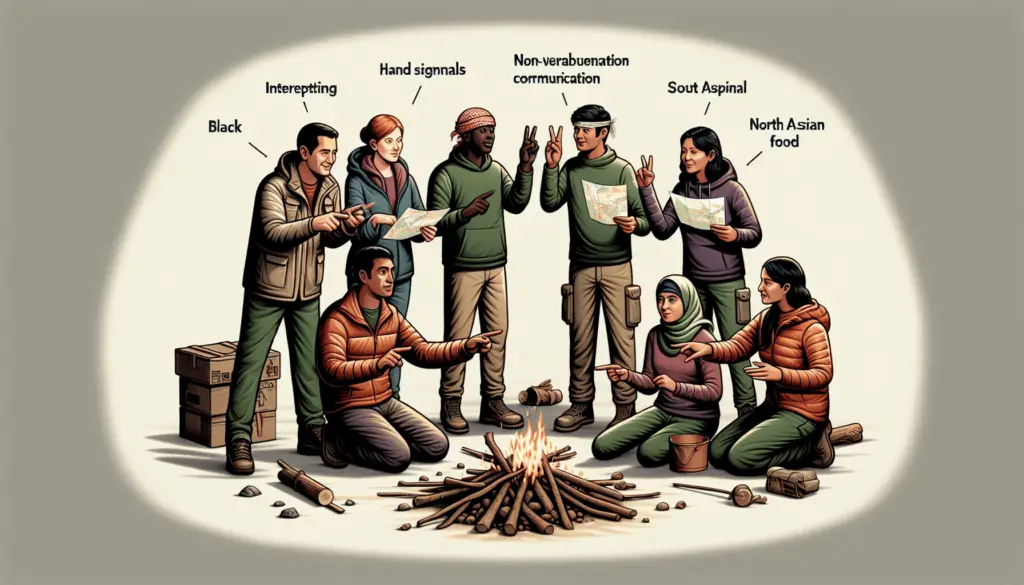Welcome, dear reader, to an insightful exploration on the significance of non-verbal communication skills in survival situations. In this article, we will discuss how the ability to understand and utilize non-verbal cues can be crucial for navigating dangerous or unpredictable circumstances. From wilderness survival to everyday emergencies, mastering these skills can make all the difference in ensuring your safety and well-being. Join us as we delve into the world of non-verbal communication and its vital role in survival. Have you ever considered the role non-verbal communication skills play in survival situations? Whether you find yourself stranded in the wilderness or navigating a high-stress emergency, the ability to communicate effectively without words can be crucial to your safety and well-being. In this article, we’ll explore the importance of non-verbal communication skills in survival scenarios and provide tips on how to improve and leverage these skills in times of need.

Understanding the Basics of Non-Verbal Communication
Non-verbal communication involves the transmission of messages without the use of words. This can include facial expressions, body language, gestures, posture, eye contact, and even the tone and pitch of your voice. In survival situations, where verbal communication may be limited or impossible, non-verbal cues become essential for conveying information, emotions, and intentions.
Understanding the basics of non-verbal communication can help you interpret and convey messages more effectively, even in the absence of verbal communication. By being aware of the signals you send and receive through non-verbal cues, you can enhance your ability to connect with others, navigate challenging situations, and ultimately increase your chances of survival.
Non-Verbal Communication Channels
non-verbal communication can involve the following channels:
-
Facial Expressions: Facial expressions can reveal a wealth of information about a person’s emotions, intentions, and reactions. A smile can signal friendliness and approachability, while a furrowed brow can indicate confusion or concern.
-
Body Language: Body language refers to the gestures, movements, and postures that we use to express ourselves. Leaning in can signal interest and engagement, while crossing your arms may indicate defensiveness or discomfort.
-
Gestures: Gestures are deliberate movements of the hands or body that can convey messages and add emphasis to verbal communication. Thumbs up can signal approval or agreement, while a hand raised palm out can signify stop or halt.
-
Posture: Posture refers to how we hold and position our bodies, which can communicate confidence, power, relaxation, or nervousness. Standing tall with shoulders back can convey strength and authority, while slouching may suggest insecurity or fatigue.
-
Eye Contact: Eye contact plays a crucial role in non-verbal communication, as it can indicate interest, attentiveness, trust, and even dominance. Maintaining eye contact can help establish connection and rapport with others.
Interpreting Non-Verbal Cues
Being able to interpret non-verbal cues accurately is essential for understanding the thoughts, feelings, and intentions of others. In survival situations, where verbal communication may be limited or hindered by external factors, being able to read and interpret non-verbal cues can help you assess threats, navigate social dynamics, and make informed decisions.
When interpreting non-verbal cues, consider the following factors:
-
Consistency: Evaluate whether verbal and non-verbal cues align or contradict each other. Incongruence between verbal and non-verbal cues may indicate deception or hidden motives.
-
Context: Consider the context in which non-verbal cues are expressed, as the same gesture or expression may carry different meanings in different situations. Pay attention to environmental cues and social norms.
-
Clusters: Look for clusters of non-verbal cues that reinforce each other, as multiple cues pointing in the same direction are more likely to be accurate indicators of thoughts or emotions.
By honing your ability to interpret non-verbal cues, you can better understand the unspoken messages conveyed by others and respond appropriately in high-stakes situations.
Enhancing Your Non-Verbal Communication Skills
Improving your non-verbal communication skills is a valuable investment that can benefit you in various aspects of life, including survival scenarios. By cultivating self-awareness, practicing active listening, and refining your body language, you can enhance your ability to convey messages effectively, build rapport with others, and navigate challenging situations with confidence.
Self-Awareness
Self-awareness is the foundation of effective non-verbal communication, as it involves understanding your own emotions, intentions, and reactions before attempting to communicate with others. By becoming more attuned to your own non-verbal cues, you can identify inconsistencies, manage stress, and convey authenticity in your interactions.
To enhance self-awareness in non-verbal communication, consider the following practices:
-
Mindfulness: Practice mindfulness techniques to cultivate present-moment awareness of your thoughts, feelings, and bodily sensations. Mindfulness can help you stay grounded, centered, and responsive in challenging situations.
-
Feedback: Seek feedback from trusted friends or colleagues about your non-verbal communication style. Ask for honest observations and insights to gain a better understanding of how others perceive you.
-
Reflection: Reflect on past interactions and assess your own non-verbal cues, both positive and negative. Identify patterns, triggers, and areas for improvement to enhance your self-awareness.
By developing self-awareness in non-verbal communication, you can become more attuned to your own emotions and intentions, which can in turn help you communicate more effectively with others in survival scenarios.
Active Listening
Active listening is a key component of non-verbal communication, as it involves not only hearing the words spoken but also understanding the emotions, context, and non-verbal cues conveyed by the speaker. By practicing active listening, you can demonstrate empathy, build trust, and establish rapport with others in high-stress situations.
To improve your active listening skills, consider the following strategies:
-
Maintain Eye Contact: Establish and maintain eye contact with the speaker to show attentiveness and engagement. Eye contact can help convey interest, empathy, and understanding in non-verbal communication.
-
Use Open Body Language: Adopt an open posture with relaxed arms and uncrossed legs to signal receptivity and openness. Open body language can encourage the speaker to express themselves freely and authentically.
-
Reflect and Clarify: Paraphrase the speaker’s words, reflect their emotions, and ask clarifying questions to ensure mutual understanding. Reflective listening can help validate the speaker’s feelings and perspectives.
By practicing active listening in non-verbal communication, you can deepen your understanding of others’ thoughts and emotions, which can be invaluable in survival scenarios where verbal communication may be limited or compromised.
Refining Body Language
Body language is a powerful tool in non-verbal communication, as it can influence how others perceive you, respond to you, and interact with you. By refining your body language, you can convey confidence, empathy, and assertiveness in survival situations, where non-verbal cues play a critical role in communication.
To refine your body language for effective non-verbal communication, consider the following tips:
-
Maintain Good Posture: Stand or sit up straight with shoulders back and head held high to project confidence and poise. Good posture can convey strength, authority, and resilience in challenging situations.
-
Gestures: Use gestures purposefully to add emphasis to your verbal communication and convey emotions effectively. Avoid excessive gestures that may distract or detract from your message.
-
Facial Expressions: Practice expressing a range of emotions through your facial expressions, from smiles to frowns to raised eyebrows. Experiment with different expressions to convey empathy, concern, excitement, or determination.
By refining your body language in non-verbal communication, you can enhance your ability to connect with others, convey messages clearly, and navigate social dynamics effectively in survival scenarios where verbal communication may be limited or compromised.
Leveraging Non-Verbal Communication Skills in Survival Situations
In survival situations, where verbal communication may be hindered by noise, distance, or other constraints, non-verbal communication skills can be invaluable for conveying information, coordinating actions, and maintaining morale among group members. By leveraging your non-verbal communication skills effectively, you can enhance your chances of survival and help others navigate challenging circumstances with clarity and confidence.
Signaling and Sign Language
Signaling is a crucial aspect of non-verbal communication in survival scenarios, as it allows individuals to convey messages over distances, in noisy environments, or without alerting potential threats. By mastering basic signaling techniques and sign language, you can communicate silently and effectively with others, even in high-stress situations.
To improve your signaling and sign language skills in survival scenarios, consider the following strategies:
-
Learn Basic Signals: Familiarize yourself with common signaling methods, such as hand signals, whistle codes, or light signals, to communicate simple messages without words. Practice these signals with group members to ensure mutual understanding.
-
Use Visual Cues: Utilize visual cues in the environment, such as smoke signals, signal mirrors, or flag symbols, to attract attention, convey messages, or indicate your location to potential rescuers. Make sure these visual cues are easily visible and recognizable.
-
Develop a Sign Language: Create a simple sign language system with your group members to communicate key messages, commands, or warnings non-verbally. Assign specific gestures or signals to common survival scenarios, such as “water,” “food,” “danger,” or “help.”
By leveraging signaling and sign language in non-verbal communication, you can establish clear communication channels, coordinate actions effectively, and enhance your group’s cohesion and resilience in survival situations where verbal communication may be limited or compromised.
Establishing Trust and Rapport
Building trust and rapport with others is essential in survival scenarios, as it fosters cooperation, collaboration, and mutual support among group members. Non-verbal communication plays a crucial role in establishing trust, as it can convey authenticity, empathy, and reliability without the need for words. By cultivating trust and rapport through non-verbal cues, you can enhance your group’s cohesion and resilience in challenging circumstances.
To develop trust and rapport through non-verbal communication in survival scenarios, consider the following strategies:
-
Demonstrate Empathy: Show empathy and compassion through your non-verbal cues, such as facial expressions, gestures, and body language. Express concern, understanding, and support for others in distress or need.
-
Share Responsibilities: Use non-verbal cues to signal your willingness to share responsibilities, resources, and tasks with group members. Collaborate effectively, communicate goals, and coordinate actions to achieve shared objectives.
-
Stay Calm and Confident: Project confidence and resilience through your non-verbal communication, even in stressful or uncertain situations. Maintain good posture, use reassuring gestures, and convey a sense of composure to inspire trust and confidence in others.
By establishing trust and rapport through non-verbal communication, you can strengthen your group’s unity, resilience, and resourcefulness in survival scenarios, where interpersonal dynamics and cohesion play a critical role in collective survival.
Conclusion
Non-verbal communication skills are an essential asset in survival situations, where spoken words may be limited or ineffective. By understanding the basics of non-verbal communication, enhancing your skills through self-awareness, active listening, and refined body language, and leveraging these skills effectively in survival scenarios, you can increase your chances of survival, establish trust and rapport with others, and navigate challenging circumstances with clarity and confidence.
Whether you find yourself in a wilderness survival scenario, a natural disaster, or a high-stress emergency situation, your ability to communicate non-verbally can make a significant difference in your safety, well-being, and ultimately, your survival. By honing your non-verbal communication skills and practicing these skills in different contexts, you can better prepare yourself for the unexpected challenges that may arise and enhance your capacity to thrive in adverse conditions.

